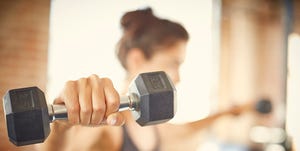
If you’re like most people, you probably use the terms “chinup” and “pullup” interchangeably to mean the same hard AF upper-body exercise. But it turns out, they’re actually not the same thing. (Yeah. Mind = blown.)
Chinup: Palms facing toward you, shoulder-width grip.
Pullup: Hands over the bar, grip wider than shoulder width.
“Both involve pulling your body up until your chin passes a bar,” he explains.
The difference: “A chinup involves the palms of your hand facing toward you, while a pullup would have your palms facing away from you,” he says.
The grip is also different. Pullups generally involve a grip that’s slightly wider than shoulder-width, Sklar says. While “chinups are typically performed with a narrower grip, approximately shoulder-width,” he says.
Here’s how to do a pullup and chinup:
Pullup: Grab the bar with an overhand grip that’s slightly wider than shoulder-width. Hang from the bar, bend your knees, and cross your ankles behind your body. Squeeze your shoulder blades together, and raise your body until your shoulders are just under the bar. Lower back to the starting position. That’s one rep. Do as many as you can.
Chinup: Using an underhand grip (palms facing you, hands shoulder-width apart), hang from a bar with elbows straight, knees bent back, and ankles crossed. Pull yourself up until your chin clears the bar and slowly lower yourself back to start. That’s one rep. Do as many as you can.

To maintain good form with both of these, you’ll want to keep your legs straight and your shoulders back, says Albert Matheny, certified strength and conditioning specialist at SoHo Strength Lab. Start from a hanging position and then pull yourself up. You’ll also want to avoid sticking your chin out over the bar (this can strain your neck) and just strive to pull yourself up as high as you can, he says.
It’s also important to note that both of these moves can be challenging to conquer immediately. If even one rep is too much on your body, try looping a sturdy resistance band around the bar, then step into it to give yourself an upward boost. Or, you can opt for an assisted pullup machine at the gym, which allows you to control how much bodyweight you’re pulling.
Do they work the same muscles?
“A lot of muscles are activated when performing a pullup or chinup,” Sklar says. The major ones targeted include your latissimus dorsi (a large muscle behind your arms), pecs, biceps, deltoids, forearms, and even the abs, he says. “In fact, pullups/chinups are one of the best abs exercises you can do.”
The big difference is that chinups work your biceps a little more, while pullups are usually more challenging as a whole, Matheny says.
When should you do chinups and pullups?
If these are new exercises to you, you’re probably going to get pretty sore from doing them, Matheny says, so you’ll want to ease into it. Striving for two or three times a week could be a good starting point, provided you feel like your muscles can take it.

Once you get the hang of pullups and chinups, you can do them every day if you want, Matheny says. Both “are great to incorporate into a variety of workouts,” Sklar says, but using them during a complex, full body workout is a great way to go.
Ultimately, the exercises are “really efficient” for working your muscles, Matheny says. “They’re a great bang for your buck.”
Source: Read Full Article
